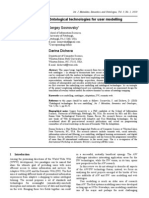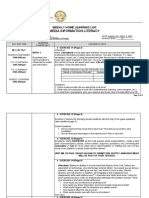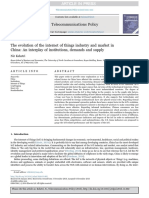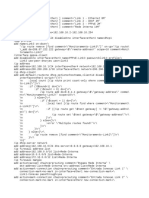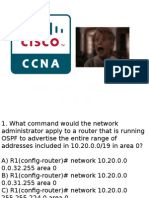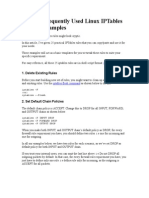Ivaschenko2018 - Modeling of User Behavior For Social Media Analysis
Ivaschenko2018 - Modeling of User Behavior For Social Media Analysis
Uploaded by
AKHIL JAISWALCopyright:
Available Formats
Ivaschenko2018 - Modeling of User Behavior For Social Media Analysis
Ivaschenko2018 - Modeling of User Behavior For Social Media Analysis
Uploaded by
AKHIL JAISWALOriginal Title
Copyright
Available Formats
Share this document
Did you find this document useful?
Is this content inappropriate?
Copyright:
Available Formats
Ivaschenko2018 - Modeling of User Behavior For Social Media Analysis
Ivaschenko2018 - Modeling of User Behavior For Social Media Analysis
Uploaded by
AKHIL JAISWALCopyright:
Available Formats
2018 Moscow Workshop on Electronic and Networking Technologies (MWENT)
Modeling of User Behavior
for Social Media Analysis
Anton Ivaschenko, Anastasiya Khorina, Vladislav Isayko, Daniil Krupin,
Viktor Bolotsky, and Pavel Sitnikov
principles of distributed simulation and decision-making
Abstract—Social media organization and analysis is one of the support powered by multi-agent technology [1]. The virtual
most interesting research areas nowadays implemented by world of social media should be treated as a complex network
modern networks and telecommunication technologies. of continuously running and co-evolving intelligent agents.
Implementation of modern social media in practice requires a
Such solutions are based on holons paradigm and bio-inspired
combination of technologies taken form technical and social
sciences. Many modern research works study it and try to approach [2], which requires development of new methods
understand the basic principles of its development and evolution. and tools for supporting fundamental mechanisms of self-
In this paper there is proposed an original model for social media organization and evolution similar to living organisms
user behavior formalization that can be used for integration of (colonies of ants, swarms of bees, etc) [3].
several social media, data import and processing using modern As for the human beings represented by actors or agents,
technologies of Big Data analysis. The proposed model allows
social network user should consider a combination of human
capturing the process of Internet user’s activity considering a
combination of human and time factors. Software solution was and time factors. Interaction of customers and service
developed for social networks analysis that provides providers powered by intermediary services generate and can
identification of positive and negative trends in users focus be characterized by a big number of events that form Big Data
evolution. The proposed approach is illustrated by the results of and require modern technologies for its analysis [4].
open data analysis taken from several popular social networks. Modeling the Internet users’ behavior can be based on the
modern principles of knowledge representation in the form of
Index Terms—Big Data, Multi-agent systems, Social Networks.
Ontologies [5]. These concepts allow formalizing self-
organization and semantics, which is advantageous for
I. INTRODUCTION abstract description of social concepts and their interaction in
technical applications.
S OCIAL networks and web communities attract the interest
of scientific researchers and IT engineers for more than 10
years. Deep study of social networks can be provided
In the context of this paper there should be mentioned the
papers on Internet development strategies [7], virtual
communities and social networks studies [8 – 9]. Despite the
nowadays using the modern technologies for Big Data successful application of mathematical statistics used to
analysis. Despite the successful application of mathematical cluster and generalize the user’s behavior the problem of Big
statistics used to cluster and generalize the user’s behavior the Data analysis of social networks remains open. This happens
problem of Big Data analysis of social networking remains due to a necessity to personalize user activity models and
still open. This happens due to a necessity to personalize user understand individual features of human behavior.
activity models and understand individual features of human Our experience in the area of integrated information space
behavior. In this paper there is proposed a possible solution for development and its users’ behavior analysis [10 – 12] can be
this problem. used to build a software solution to derive basic trends in
social media and provide intelligent functionality for social
II. STATE OF THE ART media big data analysis. The proposed abstract model and
New opportunities of interaction in virtual environments solution vision are given below.
allow Internet users to exchange the ideas immediately. At the
same time everybody needs to obtain and process lots of III. ABSTRACT MODEL
incoming events. This process can be described by the modern Let us present a community of Internet users by u i , where
i = 1.. N u– a number of users. The activity of users
A. Ivaschenko is a professor at Samara National Research University, information exchange can be presented by posts, comments or
Samara, Russia (e-mail: anton.ivashenko@gmail.com).
A. Khorina and V. Isayko are students of Samara National Research messages p j , where j = 1.. N w – an absolute number of an
University, Samara, Russia.
D. Krupin and V. Bolotsky are lead engineers at SEC “Open Code”,
informational object. Post generation is an event
Samara, Russia.
P. Sitnikov is a chair at ITMO University, Saint-Petersburg, Russia (e-
( )
g i , j = u i , p j , t i0, j (1)
mail: sitnikov@o-code.ru).
978-1-5386-3498-1/18/$31.00 © 2018 IEEE
2018 Moscow Workshop on Electronic and Networking Technologies (MWENT)
Issue or processing of an information object can be
presented by an event ei , j that can be characterized by the
combination of user, focus, and time:
( ( ))
ei , j ,k = ei , j ,k p k , u i , f i ,k ,t i , j ,k = {0,1} (2)
where focus f i ,k presents the current user interest and can be
described by a tag cloud, which is a set of pairs:
{
f i ,k = (τ n , wl ,k )i ,k } (3)
where τ n is a tag (keyword) with weight wn, k .
The sequence of interdependent user focuses represents the
evolution of the user’s interest.
Each user has own ontology that forms the basis for his
perception. It changes with time under the influence of
learning and forgetting the information (presented by posts,
comments or messages) and can be presented by a chain of
contexts:
{
ci ,m = (τ l , wl ,m )i ,m } (4)
This changing is correlated with user focus. The focus
cannot be considerably new in order to provide positive Fig. 1. Solution multi-agent architecture
perception, and at the same time it is not equal to the context
Post generator used to create posts according to predefined
to be able to excite interest.
logic. Navigator is used to process incoming data which is
Considering this correlation let us synchronize the context
described by network and can be presented like a sorted graph
and focus changes:
( ( ))
ei′, j ,m = ei′, j ,m p k , u i , ci ,m , t i , j ,m = {0,1} (5)
there the nodes are informational objects, for example web
sites, documents, posts, comments, and the links are
The statements (2) and (5) are Boolean variables, which references between these objects. Each object can refer to
mean that appearance or perception of a post, comment or several other objects and documents; and the navigator
message does not guarantee changes in focus and context. according to predefined all logic, decides, which link to go.
Events (2) and (5) can be used for analysis. One of the In addition to navigator and post generator there are
possible implementations is presented below. Study of the provided the informational frames under the multi-agent
user’s focus and context trends allows identifying tendencies, architecture that correspond to a predefined above focus and
variations and iterations that form the patterns of user context concepts. Focus is used represent the current interest
creativity. of Internet users. Context is used to formalize informational
In case new informational proposal remain suspended and space in which the agent performs its negotiating activity.
do not make any effect over the user focus, this means that the Based on the provided model there was developed an
user does not see any interest. Possible reasons are concerned algorithm for social media big data analysis. The model is
with context: additional education is needed to provoke such used to formalize the social media user and integrate the
interest. On the other side, lots of changes of the user context analytical software with various social media open for data
indicate the search for a stable interest that should be proposed import and analysis. The algorithm is presented in Fig. 2.
for the user at a certain time. This algorithm consists of 2 stages:
Context and focus can be also influenced by negative 1. Calculation of the sample frequency vector for all users
intervention. In order to manage the user focus there can be and development of the root-mean-square deviation vector for
generated a series of repeated affections partially covering the a variety of users
actual context and the targeted interest. Such patterns can also • You need to selecting topics and converting them to a view
be identified applying cross-correlation analysis to the (topic_hour, 1/users);
proposed model, which helps identification and resistance to • After process the received pairs and calculate the amount
negative informational influence. 1/user (topic_hour, ∑1/users);
• Calculate the root-mean-square deviation for each pair;
IV. SOLUTION ARCHITECTURE • The obtained values are divided by the period.
The proposed approach is based on simulation of focus and 2. Calculating the deviation metric for a particular user
context. It was implemented in multi agent architecture, which • You need to selecting topics and converting them to a view
is presented in Figure 1. Under the bounds of our proposed (topic_hour_user, 1);
architecture we provide profile descriptor, post generator and • Next you need to process of data pairs and counting the sum
navigator. These are methods generated and used to simulate of topics with the same key (topic_hour_user, sum);
real activity of users in the social networks. • Count the deviation of a particular user
2018 Moscow Workshop on Electronic and Networking Technologies (MWENT)
(topic_hour_user,∆); One of the main features of Internet users’ activity online
• Summarize the deviations of a particular user that should be considered under the explored scope is mutual
(topic_hour_user,∑∆); influence of contexts and focuses of communicating peers.
• Divide the sum of the deviations by the number of topics This factor makes it possible to introduce the control loop: in
(n) for a particular user. addition to web content semantic analysis the platform starts
After these steps you need to generate the resulting CSV- management the users interest based on focus identification
file in the form of a table with user data and information of and context feedback.
standard deviation of this user. This information is captured in social networks and has all
necessary details to get actual estimations. Still in this case it
is required to provide integration with social networks and the
data being processed contain tons of subjective assessments
and perceptions. Online libraries and professional
communities are more neutral. For example, Wikipedia
enforces various groups of authors to update the articles
targeting maximum objectivity. Analysis of this data can help
adequate identification of significant trends of consumers
focus identification that can be practically used e.g. for
marketing and product placement.
Activation method is used to simulate multi agent activities
in real times. The special agent dispatcher will call all of the
agents by using this activation method and after be activated
each agent generates the time series period according to some
distribution rule. Agent generates time series of calling
navigation and post generation methods. At this stages we
decides the proposed of navigation and generation by this
means that we can simulate post writers or post readers and
introduce some specific models of online activity, for example
the agent can be more active in night time or we can time
some time frames for high/low activity.
Focus and contexts are updates the results of real agent
behavior based on the influents of informational objects. We
can generate focus and contexts according to our goals and in
case we want to agent to behave in a sort of specific way we
introduce this control directly and formulate focus and context
the agent will do that you want. We will do behave the
specific way the other one method but this direct control not
good for real systems because there are none such direct
influence in real world but there is the sort of information
influence.
This approach allows simulating this influence and is
introduced it in multi agent system. In this case we need to
analyze the focus and contests changes of the agent during the
period of time and on this based on this analyzed we introduce
changes in focus by generating informational objects inside
this network. This can be done in real systems using the
contexts based advertisements. We can generate just the
objects with certain informational context, which can be
described by tag clouds.
The introduction of architecture can be used for simulate
online users in social networks and model realistic Internet
behavior.
In other one area of simulation, practical application is
generation of cognitive patterns of collective behavior based
Fig. 2. Social media big data analysis on self-organization. In this case the agent should be simple
and the logic of focus and context should be close to very
simple but generic behavior. This logic can correspond to
know real users of social networks but it can represent some
2018 Moscow Workshop on Electronic and Networking Technologies (MWENT)
generalized behavior and the community of agent. Such corresponds the Bot activity and can be easily identified by the
behavior can be used to study and develop some visual cases. agent comparing the behavior of previous periods. The
In another case it is implemented as a sort of a frame, using described research results show that the proposed model can
which the algorithms of syntactical analysis or other large data be used for online behavior analysis and identification of
analysis can look onto the real world of social networks and negative informational influence.
filter the data for intelligent study.
V. IMPLEMENTATION
To implement the proposed approach there was developed a
software solution for social media focus identification based
on knowledge discovery and Big Data analysis.
The solution can integrate with various data sources, pick
out concepts, generate tag clouds for contexts and focuses and
process their changes in time. Solution implementation
architecture is presented in Fig. 3. The data imported from
social networks is captured in database and can be processed
either in real time or in batch mode.
.
Fig. 4. Bot activity identification
VI. CONCLUSION
As shown above, the proposed model allows capturing the
process of Internet user’s activity considering a combination
of human and time factors.
REFERENCES
[1] M. Wooldridge, “An introduction to multi-agent systems”, John Wiley
and Sons, Chichester. 2002, 340 p.
[2] P. Leitao, “Holonic rationale and self-organization on design of complex
evolvable systems”, HoloMAS 2009, LNAI 5696, Springer-Verlag Berlin
Heidelberg. 2009. – pp. 1 – 12.
Fig. 3. Integration model [3] V. I. Gorodetskii, “Self-organization and multiagent systems: I. Models
of multiagent self-organization”, Journal of Computer and Systems
Sciences International, vol. 51, issue 2, 2012, pp. 256 – 281.
Crawler addresses asynchronously to a web service with [4] N. Bessis and C. Dobre, “Big Data and Internet of Things: A roadmap
requests for data from social networks. After receiving the for smart environments”, Studies in Computational Intelligence,
Springer. 2014. 450 p.
request, the web service starts processing it. Next, the web [5] D. Mouromtsev, D. Pavlov, Y. Emelyanov, A. Morozov, D.
service accesses the integrator, which starts downloading the Razdyakonov and M. Galkin, “The simple, web-based tool for
requested data in the form of RDF / XML files, storing the visualization and sharing of semantic data and ontologies”, CEUR
intermediate data received from the single request of the Workshop Proceedings, 2015. – pp. 77
[6] One Internet. Global commission on Internet Governance. 2016. Report.
crawler to receive the data by the single block to transfer the [7] H. Balakrishnan, N. Deo, “Discovering communities in complex
already downloaded ones. networks”, Proceedings of the 44th annual Southeast regional
Then in the background, i.e. in a mode where there is no conference, March 10–12, Melbourne, Florida, USA. 2006. – pp. 280–
285.
need to control the data unloading process, the integrator [8] W. Wei, K. Joseph, H. Liu, K.M. Carley, "Exploring Characteristics of
automatically continues the embedded process and uploads the Suspended Users and Network Stability on Twitter". Social Network
data to the database and uses Apache JENA to generate RDF / Analysis and Mining. 2016. – pp. 6 – 51
[9] C. Kadushin, “Understanding social networks: theories, concepts, and
XML files that will be transferred to the first crawler address. findings”, Oxford University Press. 2012, 264 p.
The described model, software solution and its [10] A. Ivaschenko, “Multi-agent solution for business processes
implementation was probated and tested using a typical data management of 5PL transportation provider”. Lecture Notes in Business
Information Processing, Vol. 170. 2014. pp. 110 – 120.
set derived from a number of social networks. In addition to a [11] A. Ivaschenko, A. Minaev, M. Spodobaev, “Self-mediator software for
real regular result set of social media users’ negotiation there sensor networks”, Proceedings of the 2015 International Siberian
was introduced a peak batch of posts generated by an online Conference on Control and Communications (SIBCON), 2015, 4 p.
[12] A. Ivaschenko, A. Lednev, A. Diyazitdinova, P. Sitnikov, “Agent-based
bot. Apart from the social media (getting no a prior knowledge outsourcing solution for agency service management”, Lecture Notes in
of a data structure) the big data analysis algorithms was able to Networks and Systems, vol 16. Springer, Cham, 2016. – pp. 204 – 215.
identify the online bot influence.
The results are presented in Fig. 4. Gray lines represent the
annual trends of users’ activity. The peak identified on Aug 15
You might also like
- Social Network AnalysisDocument2 pagesSocial Network AnalysisKitty KhanNo ratings yet
- POST TASK 1 Activity SheetDocument9 pagesPOST TASK 1 Activity SheetAva Solis67% (3)
- Fiscal Printer Intelligent Features Guide Rev H PDFDocument31 pagesFiscal Printer Intelligent Features Guide Rev H PDFStefano CastelliNo ratings yet
- Social Network Analysis Using Python Data Mining: Abstract-Analyzing Public Information From SocialDocument6 pagesSocial Network Analysis Using Python Data Mining: Abstract-Analyzing Public Information From SocialDedy HariyadiNo ratings yet
- Information Diffusion Online Social NetworksDocument12 pagesInformation Diffusion Online Social NetworkscesarefinmaticaNo ratings yet
- Privacy Inference Attack Against Users in Online Social Networks A Literature ReviewDocument15 pagesPrivacy Inference Attack Against Users in Online Social Networks A Literature ReviewMOHNo ratings yet
- 2005_Zhuge_SKG2005_The Knowledge Grid and Its MethodologyDocument6 pages2005_Zhuge_SKG2005_The Knowledge Grid and Its MethodologypliangengNo ratings yet
- Topic Categorization Based On User Behaviour in Random Social Networks Using Firefly AlgorithmDocument5 pagesTopic Categorization Based On User Behaviour in Random Social Networks Using Firefly AlgorithmBONFRINGNo ratings yet
- Smart E-Learning Systems With Big Data: International Journal of Electronics and Telecommunications October 2018Document7 pagesSmart E-Learning Systems With Big Data: International Journal of Electronics and Telecommunications October 2018Sagni EchimaNo ratings yet
- Media Characteristics and Social Networks Enabled Knowledge Integration in Cooperative WorkDocument10 pagesMedia Characteristics and Social Networks Enabled Knowledge Integration in Cooperative WorkJeffrey AvilaNo ratings yet
- Zaphiris, Pfeil - 2007 - Introduction To Social Network Analysis (Tutorial) - British Computer Society Conference On Human-Computer InteractionDocument2 pagesZaphiris, Pfeil - 2007 - Introduction To Social Network Analysis (Tutorial) - British Computer Society Conference On Human-Computer InteractionPanayiotis ZaphirisNo ratings yet
- Accepted ManuscriptDocument35 pagesAccepted Manuscriptlost my selfNo ratings yet
- Ad Hoc Networks - Social ObjectsDocument23 pagesAd Hoc Networks - Social ObjectsMartin MontenegroNo ratings yet
- On The Features and Challenges of Security and Privacy in Distributed Internet of Things. Computer NetworksDocument36 pagesOn The Features and Challenges of Security and Privacy in Distributed Internet of Things. Computer NetworksPool Espejo ConchaNo ratings yet
- Responsive DesignDocument17 pagesResponsive Designtaskmaster37742No ratings yet
- ICDARDocument5 pagesICDARcloudserviceuitNo ratings yet
- Ontological Technologies For User Modelling 2010Document40 pagesOntological Technologies For User Modelling 2010openid_APAKwdRcNo ratings yet
- Ubiquitous Social Media Analysis Third International Workshops, MUSE 2012Document182 pagesUbiquitous Social Media Analysis Third International Workshops, MUSE 2012scribdjicNo ratings yet
- Hans en Analyzing Social MediaDocument2 pagesHans en Analyzing Social MediatrappedreflectionNo ratings yet
- Vasanthakumar2019 - Profiling Social Media Users, A Content-Based Data Mining Technique For Twitter UsersDocument6 pagesVasanthakumar2019 - Profiling Social Media Users, A Content-Based Data Mining Technique For Twitter UsersAKHIL JAISWALNo ratings yet
- Digital Ecosystems, CollecDocument4 pagesDigital Ecosystems, Collecsaravana1115No ratings yet
- Python For Graph and Network AnalysisDocument214 pagesPython For Graph and Network AnalysisQuebec Immigration DocNo ratings yet
- Predicting_user_interaction_behavior_on_governmentDocument10 pagesPredicting_user_interaction_behavior_on_governmentMơ MơNo ratings yet
- Diffusion in Social NetworkDocument12 pagesDiffusion in Social NetworkBala GaneshNo ratings yet
- Intelligent Dynamic Enquiry For Innovation Technology: Towards Multi-Agent SystemsDocument6 pagesIntelligent Dynamic Enquiry For Innovation Technology: Towards Multi-Agent SystemsJonathan BishopNo ratings yet
- J170 A Novel Context-Aware Recommender Systems Based On A J166 Deep Sequential Learning Approach (CReS)Document12 pagesJ170 A Novel Context-Aware Recommender Systems Based On A J166 Deep Sequential Learning Approach (CReS)Timothy K ShihNo ratings yet
- ProjectDocument7 pagesProjectnithishjayarama43No ratings yet
- Architecting The IoT Paradigm A Middleware For Autonomous Distributed Sensor NetworksDocument18 pagesArchitecting The IoT Paradigm A Middleware For Autonomous Distributed Sensor NetworksThomas LagkasNo ratings yet
- Analyzing The Changes in Online Community Based On Topic Model and Self-Organizing MapDocument9 pagesAnalyzing The Changes in Online Community Based On Topic Model and Self-Organizing MapAzim KhanNo ratings yet
- Jcsa 8 2 1 PDFDocument7 pagesJcsa 8 2 1 PDFMichael MaigwaNo ratings yet
- A Trust-Aware and Authentication-Based Collaborative Method For Resource Management of Cloud-Edge Computing in Social Internet of ThingsDocument10 pagesA Trust-Aware and Authentication-Based Collaborative Method For Resource Management of Cloud-Edge Computing in Social Internet of ThingsAli Asghar Pourhaji KazemNo ratings yet
- Vere Ten Niko Va 2015Document6 pagesVere Ten Niko Va 2015Ramon CaldeiraNo ratings yet
- Digital Footprints in The Context of ProfessionalDocument15 pagesDigital Footprints in The Context of ProfessionalfloraagathaaNo ratings yet
- Maths ProjectDocument11 pagesMaths Projectdhruv.sahgal.21cseNo ratings yet
- Internet of Things Conceptual Network Structure, Main Challenges andDocument11 pagesInternet of Things Conceptual Network Structure, Main Challenges andsandro.nieto.mNo ratings yet
- Performance Analysis of User Influence Algorithm Under Big Data Processing Framework in Social NetworksDocument6 pagesPerformance Analysis of User Influence Algorithm Under Big Data Processing Framework in Social Networksvinay1214No ratings yet
- Levels of Similarity in User Profiles Based Cluster Techniques and Multidimensional ScalingDocument9 pagesLevels of Similarity in User Profiles Based Cluster Techniques and Multidimensional ScalingJonathan SimbañaNo ratings yet
- 5 2008 SNAKDD2008-WR SNAKDD 2008 - Social Network Mining and Analysis Post-Workshop ReportDocument4 pages5 2008 SNAKDD2008-WR SNAKDD 2008 - Social Network Mining and Analysis Post-Workshop Reportdonganh89No ratings yet
- Unit IvDocument23 pagesUnit IvsaraswathiNo ratings yet
- 27 Coginfocom2013sallaiDocument7 pages27 Coginfocom2013sallaisabkebernNo ratings yet
- Community Discovery in Dynamic Networks: A SurveyDocument37 pagesCommunity Discovery in Dynamic Networks: A Surveyyujay.w.linNo ratings yet
- Research Challenges of Dynamic Socio-Semantic NetworksDocument3 pagesResearch Challenges of Dynamic Socio-Semantic NetworksИван ИвановNo ratings yet
- Four Dimensions of Social Network AnalysisDocument33 pagesFour Dimensions of Social Network AnalysisbhavadharaniNo ratings yet
- The Interconnection of Internet of Things and Artificial Intelligence: A ReviewDocument11 pagesThe Interconnection of Internet of Things and Artificial Intelligence: A ReviewRitu ParnaNo ratings yet
- Digital Ecosystem Dari Beberapa Studi KasusDocument43 pagesDigital Ecosystem Dari Beberapa Studi KasusArisYamanNo ratings yet
- CMC Group-3 3104 Network-TheoryDocument27 pagesCMC Group-3 3104 Network-TheoryAbigael D. RiveraNo ratings yet
- Community Detection in Social Media: Performance and Application ConsiderationsDocument40 pagesCommunity Detection in Social Media: Performance and Application ConsiderationsnehaNo ratings yet
- Smart Campus V 8 FinalDocument11 pagesSmart Campus V 8 FinalViraat SewrajNo ratings yet
- Artículo: Improving Social CapitalDocument8 pagesArtículo: Improving Social CapitalvanlangenNo ratings yet
- SNS Unit IvDocument27 pagesSNS Unit IvAdithyaraaj R.P.No ratings yet
- Opinion Mining and Social Networks: A Promising MatchDocument6 pagesOpinion Mining and Social Networks: A Promising MatchapramunendarNo ratings yet
- 1 s2.0 S1570870522000051 Main PDFDocument15 pages1 s2.0 S1570870522000051 Main PDFMaryam KhaliqNo ratings yet
- Effects of Information and Communication Technology (ICT) On Social Science ResearchDocument9 pagesEffects of Information and Communication Technology (ICT) On Social Science ResearchHinggo BlakeNo ratings yet
- 2006 - The Impact of Social Networking 2.0 On OrganisationsDocument13 pages2006 - The Impact of Social Networking 2.0 On OrganisationsKamila de Mesquita CamposNo ratings yet
- Use of Computer in Social Science Research - August - 2012 - 5996565139 - 1304002Document2 pagesUse of Computer in Social Science Research - August - 2012 - 5996565139 - 1304002Aagya DubeyNo ratings yet
- Dynamic Generation of Internet of Things Organizational Structures Through Evolutionary ComputingDocument12 pagesDynamic Generation of Internet of Things Organizational Structures Through Evolutionary Computingdan_intel6735No ratings yet
- Scientific Co-Authorship Social Networks: A Case Study of Computer Science Scenario in IndiaDocument8 pagesScientific Co-Authorship Social Networks: A Case Study of Computer Science Scenario in Indiagopika1991No ratings yet
- Open Problems of Information Systems Research and TechnologyDocument10 pagesOpen Problems of Information Systems Research and TechnologymikelNo ratings yet
- Advanced Topics in Multimedia ResearchDocument114 pagesAdvanced Topics in Multimedia ResearchMadhava ReddyNo ratings yet
- Social Influence and Spread Dynamics in Social Networks: Xiaolong ZHENG, Yongguang ZHONG, Daniel ZENG, Fei-Yue WANGDocument10 pagesSocial Influence and Spread Dynamics in Social Networks: Xiaolong ZHENG, Yongguang ZHONG, Daniel ZENG, Fei-Yue WANGGrazielle AlessaNo ratings yet
- Sample Article Chi Square TestDocument18 pagesSample Article Chi Square TestGAYATHIRI A/P MANOHARAN MoeNo ratings yet
- Advance Java Unit 1 Prof Akhil M JaiswalDocument38 pagesAdvance Java Unit 1 Prof Akhil M JaiswalAKHIL JAISWALNo ratings yet
- Correlation of Brand Mentions in Social Media and Web Searching Before and After Real Life EventsDocument6 pagesCorrelation of Brand Mentions in Social Media and Web Searching Before and After Real Life EventsAKHIL JAISWALNo ratings yet
- Martono2016 - Utilization of Social Media in Livestock Product Marketing Group of CattleDocument5 pagesMartono2016 - Utilization of Social Media in Livestock Product Marketing Group of CattleAKHIL JAISWALNo ratings yet
- Hovad2015 - Real-Time Web Mining Application To Support Decision-Making ProcessDocument8 pagesHovad2015 - Real-Time Web Mining Application To Support Decision-Making ProcessAKHIL JAISWALNo ratings yet
- Comparing A Traditional Approach For Financial Brand Communication Analysis With A Big Data Analytics TechniqueDocument9 pagesComparing A Traditional Approach For Financial Brand Communication Analysis With A Big Data Analytics TechniqueAKHIL JAISWALNo ratings yet
- Cvijikj2011 - Monitoring Trends On FacebookDocument8 pagesCvijikj2011 - Monitoring Trends On FacebookAKHIL JAISWALNo ratings yet
- Terskikh2018 - Specific Features of The Communication Strategy of Sports Brands Promotion in Social NetworksDocument3 pagesTerskikh2018 - Specific Features of The Communication Strategy of Sports Brands Promotion in Social NetworksAKHIL JAISWALNo ratings yet
- Vasanthakumar2019 - Profiling Social Media Users, A Content-Based Data Mining Technique For Twitter UsersDocument6 pagesVasanthakumar2019 - Profiling Social Media Users, A Content-Based Data Mining Technique For Twitter UsersAKHIL JAISWALNo ratings yet
- Download full The Afterlife of Data: What Happens to Your Information When You Die and Why You Should Care 1st Edition Carl Öhman ebook all chaptersDocument47 pagesDownload full The Afterlife of Data: What Happens to Your Information When You Die and Why You Should Care 1st Edition Carl Öhman ebook all chapterssusmanbodea100% (2)
- Legal and Ethical Issues in Computing Week 2 Lecture 3 & 4Document44 pagesLegal and Ethical Issues in Computing Week 2 Lecture 3 & 4Sana KhanNo ratings yet
- What We Learned in 22 and Where Search Is Going in 23Document31 pagesWhat We Learned in 22 and Where Search Is Going in 23FakhzanBadiranNo ratings yet
- WAP OverviewDocument24 pagesWAP OverviewFachrizal Rizky FerdiansyahNo ratings yet
- 4.1.3.5 Packet Tracer - Configure Standard IPv4 ACLs - ILMDocument13 pages4.1.3.5 Packet Tracer - Configure Standard IPv4 ACLs - ILMdiego rubioNo ratings yet
- Week 1 - 2 - Weekly Learning LogDocument4 pagesWeek 1 - 2 - Weekly Learning LogedzNo ratings yet
- E ManufacturingDocument13 pagesE ManufacturingIkramNo ratings yet
- Telecommunications Policy: Nir KshetriDocument19 pagesTelecommunications Policy: Nir KshetriDianaNo ratings yet
- Thesis Chapter 1& 2 New RowenaDocument18 pagesThesis Chapter 1& 2 New RowenaPrint HubNo ratings yet
- Orca Share Media1662936986514 6974863254286900222Document43 pagesOrca Share Media1662936986514 6974863254286900222jelly yohemNo ratings yet
- Introduction To NetworkingDocument52 pagesIntroduction To NetworkingSolulele SnymanNo ratings yet
- H3 CDocument35 pagesH3 Ctom.wisetechNo ratings yet
- 350-801 Agosto 62qDocument26 pages350-801 Agosto 62qJorge ArmasNo ratings yet
- CISv2 Student Guide - Final PDFDocument545 pagesCISv2 Student Guide - Final PDFShyam VermaNo ratings yet
- The Letters of Ron PriceDocument125 pagesThe Letters of Ron PriceRonPrice100% (1)
- Ace TroubleshootingDocument182 pagesAce TroubleshootingjtfoleyNo ratings yet
- JournalofInternationalCommunication 2012 PDFDocument13 pagesJournalofInternationalCommunication 2012 PDFEriq FauzieNo ratings yet
- Social Media HaS DraStically Changed How We Communicat1Document2 pagesSocial Media HaS DraStically Changed How We Communicat1mohdsabirNo ratings yet
- Script Geral para LerDocument3 pagesScript Geral para LerTI RIBEIRO ASSESSORIA CONTABILNo ratings yet
- Communication Media ChannelsDocument23 pagesCommunication Media Channelsjoel100% (2)
- Study guide for Exam AZ-700Document7 pagesStudy guide for Exam AZ-700Adilson PedroNo ratings yet
- HTML and CssDocument127 pagesHTML and CssSakkthi PrabhaNo ratings yet
- Ccna Shock Exam Set ADocument47 pagesCcna Shock Exam Set ANerwin PagulayanNo ratings yet
- 25 Most Frequently Used Linux IPTables Rules ExamplesDocument8 pages25 Most Frequently Used Linux IPTables Rules ExamplesictnewNo ratings yet
- Technology As A Driving Force For GrowthDocument2 pagesTechnology As A Driving Force For Growtharjinder kaurNo ratings yet
- Internet Protocol (Ipv4) : Tcp/Ip Protocol SuiteDocument55 pagesInternet Protocol (Ipv4) : Tcp/Ip Protocol SuiteMuhammad ImranNo ratings yet
- Impact Irri TrainingDocument13 pagesImpact Irri TrainingrscordovaNo ratings yet
- Harmful Traits of The Google Effect On TeachingDocument4 pagesHarmful Traits of The Google Effect On TeachingdoraNo ratings yet
















